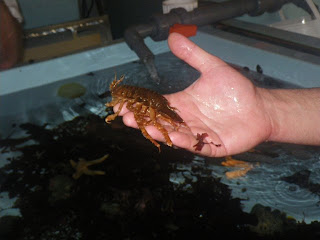Lots of scientists such as glaciologists, geologists and ice core drillers use Rothera to fly to remote areas of Antarctica where they will camp while doing their work. However there is lots of science activity at the station itself.
There are some really good laboratories for the biologists. Many of the biologists dive into the cold waters around Rothera and bring back no end of strange and wonderful animals.
Biology is not my expertise, but as far as I can tell some of the main things they are studying is how the animals will react to the changing temperatures on the peninsula, and how the food chain is involved in C02 drawdown into the southern
ocean.
Rothera has many meteorological and climate studies. There is a full met station here and many automatic weather stations on the peninsula that are deployed and maintained from Rothera. Four met balloons are launched a week which measure temperature, humidy and wind to about 30km in the atmosphere. The radars here give temperatures and winds at higher altitudes than that, up to about 100km. There are also optical instruments, Very Low Frequency receivers and magnetometers that reach higher still. Here are I am deploy an instrument here called a search coil magnetometer.
I like the search coil magnetometer - it looks like something that Dr Who might have in the Tardis.



WOW AMAZING!
ReplyDeleteOn the surface, if you are lucky, you get to see seals, penguins and whales. The divers are even luckier they get to see all the amazing stuff under the sea and amazingly under the dark cold waters of the Antarctic there is a lot of live and a huge diversity.
Deletehave you been digging holes again?
ReplyDeleteOh yes, it doesn't matter what you do, if you are in the Antarctic it always seems as if digging is involved!
Delete